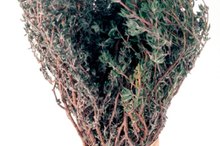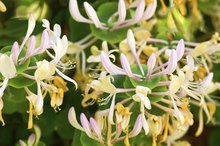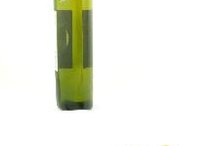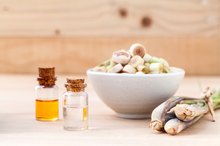Karanja Oil Compared to Neem Oil
Karanja and neem oils both have been used widely in India for centuries to cure a variety of ailments. They are still used in Ayurvedic medicine, as well as by cosmetic companies and companies that manufacture pesticides. While there is a long tradition of medical use for both karanja and neem oils, more clinical study is needed on their benefits and possible complications, such as interactions with medicines.
History
Neem oil has been used in India since at least 4000 BC. It’s been referred to in ancient Indian scripts as "the curer of all ailments." Neem trees have long been considered good luck in India and are often referred to as “the village pharmacy,” according to Uncle Harry’s Natural Products of Redmond, Washington.
**Karanja oil has been used in India for hundreds of years.
It’s a hardy plant that can thrive in many conditions. It can now be found in Florida, Hawaii, Australia, Vietnam, Malaysia, the Seychelles, Oceania and the Philippines. **
- Neem oil has been used in India since at least 4000 BC.
- Neem trees have long been considered good luck in India and are often referred to as “the village pharmacy,” according to Uncle Harry’s Natural Products of Redmond, Washington.
Identification
What Are the Health Benefits of Fenugreek & Thyme?
Learn More
Neem oil is cold-pressed from kernels of fruit from the Azadirachta indica tree, which is an evergreen 4. All parts of the tree can be used medicinally, according to University of Oklahoma’s Plant of the Week website. The main active ingredient in neem is azadirachtin, an insect repellent. Karanja oil is cold-pressed from seeds of the Pongam tree. The oil is reddish-brown, rather viscous and non-edible.
Karanja oil has a milder aroma than neem oil.
Karanja oil’s aroma often is described as "nutty." Thus, it’s seen as more versatile than neem oil for use in products like soaps and shampoos.
- Neem oil is cold-pressed from kernels of fruit from the Azadirachta indica tree, which is an evergreen 4.
- Karanja oil has a milder aroma than neem oil.
Function
Neem oil is used both internally and externally. It is thought to prevent free-radical damage in the body, remove toxins and purify blood. Neem’s medicinal properties are antibacterial, antidiabetic, antimalarial, antitumor and antiulcer. It’s also thought to have positive effects on the cardiovascular and central nervous systems. Neem oil contains essential fatty acids and vitamin E. Karanja oil is a cousin to neem oil, so has similar therapeutic benefits.
Karanja oil is most prized and used for its antiseptic and insecticidal functions. It's most often used externally.
- Neem oil is used both internally and externally.
- Neem oil contains essential fatty acids and vitamin E. Karanja oil is a cousin to neem oil, so has similar therapeutic benefits.
Use
Side Effects of Frankincense Oil
Learn More
Neem is a key herb for both Ayurvedic and Unani medicine. It’s used in treating a wide variety of illnesses, diseases and problems, including psoriasis, herpes, allergies, ulcers, hepatitis, cancer, periodontal disease and to boost the immune system. Neem is often used in toothpastes, lotions and soaps today. It’s also used as a natural insecticide. Taken internally, neem is purported to kill parasites and pathogens.
Karanja is used in Ayurvedic and folk medicines for eye ailments and skin diseases such as eczema, rheumatism, wounds and worms. It’s also used to prevent bacterial growth in the mouth. Karanja is a natural pest repellent used agriculturally and for human and pet use against lice, mosquitoes, fleas, ticks, mites and flies. The oil is widely used in soaps, leather tanning and topical liniments. When mixed together, karanja and neem oils are effective for treating mange in pets.
- Neem is a key herb for both Ayurvedic and Unani medicine.
- Neem is often used in toothpastes, lotions and soaps today.
Considerations
Few studies have been done on drug interactions for these oils, so people who use medications need to check with a doctor before use. Because of neem and karanja oils' strength, producers recommend caution if using internally.
Children, nursing moms and pregnant women should not use the oils internally. The long-term use of neem oil has been linked with both kidney and liver dysfunction and large doses of neem may be toxic.
- Few studies have been done on drug interactions for these oils, so people who use medications need to check with a doctor before use.
- Children, nursing moms and pregnant women should not use the oils internally.
Related Articles
References
- Journal of Economic Entomology Effect of Commercially Available Plant-Derived Essential Oil Products on Arthropod Pests
- Botanical.com: Neem Seed Oil
- UncleHarrys.com: Neem Oil
- PlantoftheWeek.org: Azadirachta Indica
- Jalaluddin M, Rajasekaran UB, Paul S, Dhanya RS, Sudeep CB, Adarsh VJ. Comparative Evaluation of Neem Mouthwash on Plaque and Gingivitis: A Double-blind Crossover Study. J Contemp Dent Pract. 2017;18(7):567-571. doi:10.5005/jp-journals-10024-2085
- Pai MR, Acharya LD, Udupa N. Evaluation of antiplaque activity of Azadirachta indica leaf extract gel--a 6-week clinical study. J Ethnopharmacol. 2004;90(1):99-103. doi:10.1016/j.jep.2003.09.035
- Almas K. The antimicrobial effects of extracts of Azadirachta indica (Neem) and Salvadora persica (Arak) chewing sticks. Indian J Dent Res. 1999;10(1):23-6. doi:10865390
- Maity P, Biswas K, Chattopadhyay I, Banerjee RK, Bandyopadhyay U. The use of neem for controlling gastric hyperacidity and ulcer. Phytother Res. 2009;23(6):747-55. doi:10.1002/ptr.2721
- Paul R, Prasad M, Sah NK. Anticancer biology of Azadirachta indica L (neem): a mini review. Cancer Biol Ther. 2011;12(6):467-76. doi:10.4161/cbt.12.6.16850
- Abiy E, Gebre-michael T, Balkew M, Medhin G. Repellent efficacy of DEET, MyggA, neem (Azedirachta indica) oil and chinaberry (Melia azedarach) oil against Anopheles arabiensis, the principal malaria vector in Ethiopia. Malar J. 2015;14:187. doi:10.1186/s12936-015-0705-4
Writer Bio
Linda Tarr Kent is a reporter and editor with more than 20 years experience at Gannett Company Inc., The McClatchy Company, Sound Publishing Inc., Mach Publishing, MomFit The Movement and other companies. Her area of expertise is health and fitness. She is a Bosu fitness and stand-up paddle surfing instructor. Kent holds a bachelor's degree in journalism from Washington State University.








